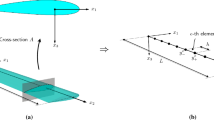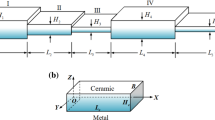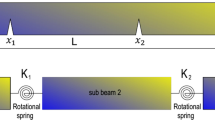Abstract
The objective of the current paper is to present a Ritz-type analytical model for predicting the behavior of discontinuous beams such as thin-walled beams with cracks and multiply-stepped beams. The beam is discretized in the cracked as well as the un-cracked domains for a cracked thin-walled beam and in uniform beams for a multiple-stepped beam. A set of local trigonometric trial functions is used to define the twist angle for the cracked domain and the un-cracked domains, as well as to define the displacement field for uniform domains. A global equation system of unknown Ritz coefficients is derived by minimizing the Lagrangian functional or the total potential energy. In the present Ritz model, the interface continuity conditions between sub-domains are investigated and enforced into the global equation system using the condensation procedure or the Lagrange multipliers. Examples are presented to illustrate the effectiveness of the current model for free vibration and torsional analysis. Results obtained from the current model are found to agree well with those obtained using a detailed finite element method or with existing results in literature. The proposed model offers an efficient approach to reduce the modeling efforts and computational time required to analyze complex beams with cracks or multiple steps.
Similar content being viewed by others
References
Taleb NJ, Suppiger EW (1961) Vibration of stepped beams. J Aerosp Sci 28: 295–298
Buckens F (1963) Eigenfrequencies of nonuniform beams. AIAA J 1: 121–127
Klein L (1974) Transverse vibrations of non-uniform beams. J Sound Vib 37: 491–505
Maurizi MJ, Belles PM (1993) Free vibration of stepped beams elastically restrained against translation and rotation at one end. J Sound Vib 163: 188–191
Lee HP, Ng TY (1994) Vibration and buckling of a stepped beam. Appl Acoust 42: 257–266
Popplewell N, Daqing Chang (1996) Free vibrations of a complex Euler–Bernoulli beam. J Sound Vib 190: 852–856
Levinson M (1976) Vibrations of stepped strings and beams. J Sound Vib 49: 287–291
Jang SK, Bert CW (1989) Free vibration of stepped beams: exact and numerical solutions. J Sound Vib 130: 342–346
Jang SK, Bert CW (1989) Free vibration of stepped beams: higher mode frequencies and effects of steps on frequency. J Sound Vib 132: 164–168
Naguleswaran S (2002) Vibration of an Euler–Bernoulli beam on elastic end supports with up to three step changes in cross-section. Int J Mech Sci 44: 2541–2555
Subramanian G, Balasubramanian TS (1987) Beneficial effects of steps on the free vibration characteristics of beams. J Sound Vib 118: 555–560
Laura PAA, Rossi RE, Pombo JL, Pasqua D (1991) Dynamic stiffening of straight beams of rectangular cross-section: a comparison of finite element predictions and experimental results. J Sound Vib 150: 174–178
Tsukazan T (2005) The use of a dynamical basis for computing the modes of a beam system with a discontinuous cross-section. J Sound Vib 281: 1175–1185
Koplow MA, Bhattacharyya A, Mann BP (2006) Closed form solutions for the dynamic response of Euler–Bernoulli beams with step changes in cross section. J Sound Vib 295: 214–225
Yavari A, Sarkani S, Reddy JN (2001) On nonuniform Euler–Bernoulli and Timoshenko beams with jump discontinuities: application of distribution theory. Int J Solids Struct 38: 8389–8406
Biondi B, Caddemi S (2005) Closed form solutions of Euler–Bernoulli beams with singularities. Int J Solids Struct 42: 3027–3044
Biondi B, Caddemi S (2007) Euler–Bernoulli beams with multiple singularities in the flexural stiffness. Eur J Mech A-Solid 26: 789–809
Wang J, Qiao P (2007) Vibration of beams with arbitrary discontinuities and boundary conditions. J Sound Vib 308: 12–27
Batra RC, Porfiri M, Spinello D (2008) Free and forced vibrations of a segmented bar by a meshless local Petrov–Galerkin (MLPG) formulation. Comput Mech 41: 473–491
Lu ZR, Huang M, Liu JK, Chen WH, Liao WY (2009) Vibration analysis of multiple-stepped beams with the composite element model. J Sound Vib 322: 1070–1080
Jaworski JW, Dowell EH (2008) Free vibration of a cantilevered beam with multiple steps: Comparison of several theoretical methods with experiment. J Sound Vib 312: 713–725
Papangelis JP, Hancock GJ (1995) Computer analysis of thin-walled structural members. Comput Struct 56: 157–176
Kapania RK, Castel F (1990) A simple element for aeroelastic analysis of undamaged and damaged wings. AIAA J 28: 329–337
Dimarogonas AD (1996) Vibration of cracked structures: a state of the art review. Eng Fract Mech 55: 831–857
Surace C, Ruotolo R (1997) Damage assessment of multiple cracked beams: numerical results and experimental validation. J Sound Vib 206: 567–588
Chondros TG, Dimarogonas AD, Yao J (1998) A continuous cracked beam’s vibration theory. J Sound Vib 215: 17–34
Song O, Ha TW, Librescu L (2003) Dynamics of anisotropic composite cantilevers weakened by multiple transverse open cracks. Eng Fract Mech 70: 105–123
Wang K, Inman DJ (2007) Crack-induced effects on aeroelasticity of an unswept composite wing. AIAA J 45: 542–551
Wang K, Inman DJ, Farrar CR (2005) Modeling and analysis of a cracked composite cantilever beam vibrating in coupled bending and torsion. J Sound Vib 284: 23–49
Dang TD, Kapania RK, Patil MJ (2010) Analytical modeling of cracked thin-walled beams under torsion. AIAA J 48: 664–675
Leissa AW (2005) The historical bases of the Rayleigh and Ritz methods. J Sound Vib 287: 961–978
Courant R (1943) Variational methods for the solution of problems of equilibrium and vibrations. Bull Am Math Soc 49: 1–23
Cook RD, Malkus DS, Plesha ME, Witt RJ (2002) Concepts and applications of finite element analysis, 4th edn. Wiley, New York
Kumar SYV, Paik JK (2004) Buckling analysis of cracked plates using hierarchical trigonometric functions. Thin Wall Struct 42: 687–700
Beslin O, Nicolas J (1997) A hierarchical functions set for predicting very high order plate bending modes with any boundary conditions. J Sound Vib 202: 633–655
Barrette M, Berry A, Beslin O (2000) Vibration of stiffened plates using hierarchical trigonometric functions. J Sound Vib 235: 727–747
Strang G, Fix G (2008) An analysis of the finite element method. New Edition. Wellesley-Cambridge Press, Massachusetts
Bardell NS (1991) Free vibration analysis of a flat plate using the hierarchical finite element method. J Sound Vib 151: 263–289
Kapania RK, Singhvi S (1992) Efficient free vibration analysis of generally laminated skew plates. Compos Eng 2: 197–212
Singhvi S, Kapania RK (1994) Comparison of simple and Chebychev polynomials in Rayleigh–Ritz analysis. J Eng Mech-ASCE 120: 2126–2135
Gjelsvik A (1981) The theory of thin walled bars. Wiley, New York
Gunnlaugsson GA, Pedersen PT (1982) A finite element formulation for beams with thin walled cross-sections. Comput Struct 15: 691–699
Moes N, Dolbow J, Belytschko T (1999) A finite element method for crack growth without meshing. Int J Numer Methods Eng 46: 131–150
Author information
Authors and Affiliations
Corresponding author
Rights and permissions
About this article
Cite this article
Dang, T.D., Kapania, R.K. & Patil, M.J. Ritz analysis of discontinuous beams using local trigonometric functions. Comput Mech 47, 235–250 (2011). https://doi.org/10.1007/s00466-010-0540-y
Received:
Accepted:
Published:
Issue Date:
DOI: https://doi.org/10.1007/s00466-010-0540-y




